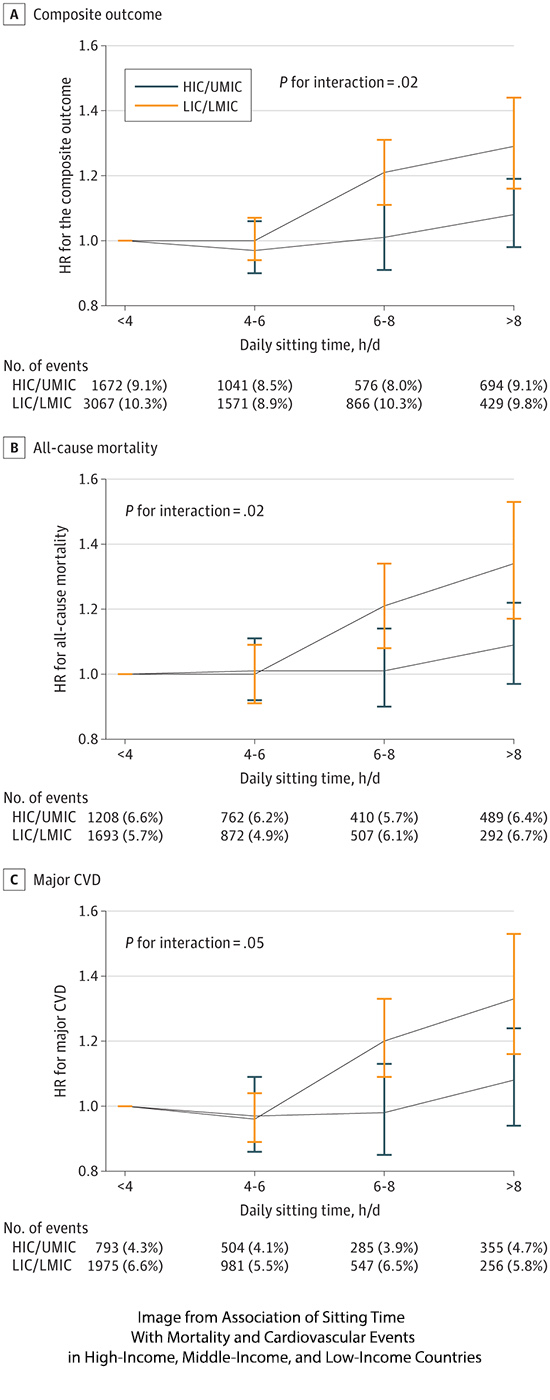Unlike other research, which most often considers the population in North American and Europe's high-income countries, the authors focused on a range of countries categorized by income level. From high-income (HIC), upper and lower middle income (UMIC, LMIC), and low-income countries (LIC) globally. Their data set, Prospective Urban Rural Epidemiology (PURE), contains information on a global population aged 35 to 70 across 21 countries. [1]
The ”exposure” variable was based on two questions, “During the last seven days, how much time did you usually spend sitting on a usual (1) weekday and (2) weekend day?” Of course, this is both self-reported and may not reflect the changing patterns of their sitting over the median follow-up period of 11 years. But let your heart be still and accept the information, flawed as it might be. The “outcome” variables were all-cause mortality and major cardiovascular events, including cardiovascular deaths, non-fatal heart attacks, heart failure, and strokes.
The Numbers
- Data was collected between 2003 and 2016 and included 90% of those with complete data, about 106,000 participants.
- Median age 50, 58% women, 42% men
- Median follow-up 11 years
Here is what they found:
- Median daily sitting time, 4 hours. “..ranging from 2.6 hours per day in Poland and Chile to 7.3 hours per day in Saudi Arabia.”
- People with higher sitting times, >8 hours daily, more often lived in urban areas; in HIC or UMIC countries, with greater education (including trade schools) and lower physical activity levels. This is the global “couch potato.”
- At baseline, those individuals with more than 8 hours of sitting also had more physical impairments, chronic health problems, depression, and diabetes - they were "sicker." As a result, the contrast with individuals sitting less than 4 hours is an apple-oranges comparison.
- During the follow-up, there were 6233 deaths (including 1792 cardiovascular deaths – 28% of the total) and 5696 cardiovascular events.
- Additionally, the data showed 2369 heart attacks, 2966 strokes, and 671 cases of heart failure
- For all-cause mortality sitting longer than 6 hours increases your risk of death by 13% compared with sitting 4 hours or less; with more than 8 hours of sitting, the risk increases to 19%. When each adverse outcome was considered separately, the increased risk was about 20%, except for heart failure, where the risk of being sedentary rose to 50%.
In evaluating these findings, remember that those in the 8-hour grouping were more ill at the outset. In another study of individuals with heart failure, where the heart pumps less effectively, the median survival at ten years from diagnosis, irrespective of their activity, is 50%. Given that baseline, being sedentary exerted little impact.
 Dose-Response
Dose-Response
Treating sitting as a “dose,” the research generated these dose-response curves. In each instance, there is an inflection upwards after 4 to 6 hours of sitting. If you believe in the "mathmagic" of the results, that is the sweet spot for how many hours you can sit in a chair or couch, at work or home, and avoid adverse health outcomes.
Perhaps a more salient observation is that these outcomes were worse in LMIC (lower-middle) and LIC (lower income) countries. What up with that?
Consider composite outcomes. Here you can readily see the increased risk of sitting for those living in a LIC or LMIC country – 30%. In point of fact, the researchers could not demonstrate a statistically significant impact of sitting on this outcome for HIC or UMIC countries. What makes these countries different other than income?
The researchers offer up a few hypotheses. It could be due to "experimental error," where variations in the methods used to measure sitting time gave spurious results.
Or there might be different variables that travel along with sitting, confounders. For example, sitting while watching television, is associated with “lower socioeconomic positions;” while "occupational" sitting is associated with higher socioeconomic levels. For those of us chair-bound at work, you can further mitigate the satanic risk of sitting by increasing your other physical activity. Of course, if that is the case, it's not the sitting that makes the difference. It is the socioeconomic level.
Could it actually be that differences in healthcare in these LIC and LMIC countries are not as protective of the sedentary as in the MIC and HIC countries?
I am reminded of an old joke about the man who prays daily to win the lottery, admonishing God for not answering his prayer. One day after saying, “Please God, today let me win the lottery. Why have you abandoned your servant?” he hears a voice speaking back, “Schmuck, you have to buy a ticket!” Perhaps this is true for our health, our health system can bring you better health, but it would be wise to help out, get out of the chair, off the couch, and enjoy a walk outside.
[1] The countries included “4 HICs: Canada, Saudi Arabia, Sweden, and United Arab Emirates; 7 upper-middle–income countries [UMICs]: Argentina, Brazil, Chile, Malaysia, Poland, South Africa, Turkey; 5 lower-middle–income countries [LMICs]: China, Colombia, Iran, Palestine, the Philippines; and 5 LICs: Bangladesh, India, Pakistan, Tanzania, and Zimbabwe.”
Source: Association of Sitting Time With Mortality and Cardiovascular Events in High-Income, Middle-Income, and Low-Income Countries JAMA Cardiology DOI:10.1001/jamacardio.2022.1581




